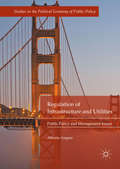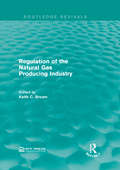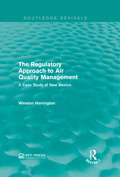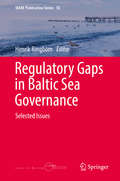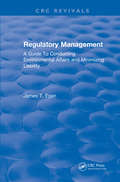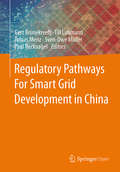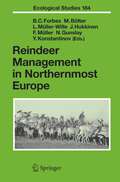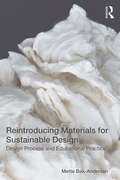- Table View
- List View
Regulation of Biological Control Agents
by Ralf-Udo EhlersThis book presents a comprehensive compilation of registration requirements necessary for authorisation of biological control agents (viruses, bacteria, fungi, active substances of natural origin and semiochemicals) in OECD countries. It also reviews data requirements for invertebrate agents (insect, mites and nematodes) and provides proposals for harmonisation of the regulation process and guidelines for completion of application forms. Based on results of the EU REBECA Policy Support Action, which gathered experts from academia, regulation authorities and industry, risks and benefits of the specific agents were reviewed and proposals for a more balanced registration process elaborated, including recommendations for acceleration of the authorisation process and discussions on trade-off effects and policy impacts. All these aspects are covered in detail in this book, which points the way forward for enhanced utilisation of biological control agents.
Regulation of Infrastructure and Utilities: Public Policy and Management Issues
by Alberto AsquerThis book provides a comprehensive discussion of the public policy and management issues that are encountered in the regulation of infrastructure and utilities. Drawing from theoretical arguments and several case studies, the book is divided into three parts, namely devising regulation, installing regulation, and making regulation work. The first part covers theories of regulation, regulatory policies, strategies and tools, and regulatory reforms. The second part deals with the politics of regulation and regulatory capacity. The third part discusses regulatory commitment and investments, the performance of regulated industries, and the design of regulatory systems. Case studies pay attention to various sectors (including water, electricity, telecommunications, highways, railways, district heating, and airports) from countries in every region of the world. ; ;
Regulation of Infrastructure and Utilities: Public Policy and Management Issues
by Alberto AsquerThis book provides a comprehensive discussion of the public policy and management issues that are encountered in the regulation of infrastructure and utilities. Drawing from theoretical arguments and several case studies, the book is divided into three parts, namely devising regulation, installing regulation, and making regulation work. The first part covers theories of regulation, regulatory policies, strategies and tools, and regulatory reforms. The second part deals with the politics of regulation and regulatory capacity. The third part discusses regulatory commitment and investments, the performance of regulated industries, and the design of regulatory systems. Case studies pay attention to various sectors (including water, electricity, telecommunications, highways, railways, district heating, and airports) from countries in every region of the world. ; ;
Regulation of Nutrient Uptake by Plants: A Biochemical and Molecular Approach
by Gyanendra Nath MitraThis book describes the mechanisms of nutrient taken up by plants at the biochemical and molecular level. This is a new concept developed over the past 30 years, primarily due to use of modern technology developed in biotechnological research, instrumentation, modern computation facilities, bioinformatics, the large volumes of information generated by use of various ‘omics’ and of course the dedicated hard work of a large number of researchers.Recent research indicates that nutrient uptake, its transport and redistribution in plants are under genetic control. There are groups of genes for each nutrient that encode transporter proteins whose functions are to acquire the specific nutrient from the soil and transport it across the plasma membrane of the root hair cells for use in plant metabolism. Deficiency or sufficiency of a plant nutrient induces different groups of genes to produce m-RNA transcripts for translation of transporter proteins. A large number of metabolic enzymes are up or down regulated in response to deficiency of plant nutrients. Morphological and metabolic adaptations in order to better acquire nutrients and use them frugally when nutrients are scarce in the growth medium can be observed in plants. Heavy metals, which are toxic to plants, induce different sets of defence mechanisms.In 20 chapters, the book describes plants’ uptake mechanisms for all the major, secondary and micronutrients, beneficial elements and heavy metals. References to research work quoted in the text are updated up to 2014 and included at the end of each chapter. Biotechnological approaches to improving nutrient use efficiency are discussed wherever such information is available. The structure and functions of transporter proteins involved in the uptake of nutrients are discussed. Additional information on some of the specific topics is provided in text boxes or as separate sections within the chapters. Lastly, the terminology used has been explained as far as possible in the text, mostly within parentheses.
Regulation of Outer Space: International Space Law and the State (Routledge-Giappichelli Studies in Law)
by Marco FerrazzaniThis edited book focuses on how States should regulate activities in space and explores strategies to advance State responsible behaviour to ensure sustainable use and effective protection of outer space for peaceful purposes. The time seems ripe to bring international law into the space sustainability discourse. The concept of sustainable development was conceptualized by the 1987 Brundtland Report, Our Common Future. Today, as then, the overlap between the security, environmental and economic dimensions, including in terms of intra/inter-generational equity, is reflected within the current ‘new space’ era that is now ‘our common future’. This edited book collects original theoretical and empirical contributions. It contributes to unpack the international outer space regulatory framework in the light of current trends and pressing challenges. This offers a unique perspective and guidance thus empowering regulatory strategies for stakeholders and end-users such as scholars, policy-makers, industry and society.
Regulation of Outer Space: International Space Law and the State (Routledge-Giappichelli Studies in Law)
This edited book focuses on how States should regulate activities in space and explores strategies to advance State responsible behaviour to ensure sustainable use and effective protection of outer space for peaceful purposes. The time seems ripe to bring international law into the space sustainability discourse. The concept of sustainable development was conceptualized by the 1987 Brundtland Report, Our Common Future. Today, as then, the overlap between the security, environmental and economic dimensions, including in terms of intra/inter-generational equity, is reflected within the current ‘new space’ era that is now ‘our common future’. This edited book collects original theoretical and empirical contributions. It contributes to unpack the international outer space regulatory framework in the light of current trends and pressing challenges. This offers a unique perspective and guidance thus empowering regulatory strategies for stakeholders and end-users such as scholars, policy-makers, industry and society.
Regulation of the Natural Gas Producing Industry (Routledge Revivals)
by Keith C. BrownOriginally published in 1972, Regulation of the Natural Gas Producing Industry combines several papers prepared for a seminar in Washington D.C in 1970.The purpose of this seminar was to exchange views between specialists on the issues related to regulation natural gas production. As such these papers explore issues such as producer price regulations, arguments for and against the regulation of natural gas, the changing environment of natural gas supply and what the future holds in terms of the natural gas producing industry. This title will be of interest to students of Environmental Studies and policy makers.
Regulation of the Natural Gas Producing Industry (Routledge Revivals)
by Keith C. BrownOriginally published in 1972, Regulation of the Natural Gas Producing Industry combines several papers prepared for a seminar in Washington D.C in 1970.The purpose of this seminar was to exchange views between specialists on the issues related to regulation natural gas production. As such these papers explore issues such as producer price regulations, arguments for and against the regulation of natural gas, the changing environment of natural gas supply and what the future holds in terms of the natural gas producing industry. This title will be of interest to students of Environmental Studies and policy makers.
The Regulatory Approach to Air Quality Management: A Case Study of New Mexico (Routledge Revivals)
by Winston HarringtonIn the wake of the Clean Air Amendments of 1970 in the United States, sources of emissions could be held accountable for the degradation of air quality in the local environment. This case study of air quality management in New Mexico was produced to shed some light on the procedures and activities used by agencies in order to control air quality. Originally published in 1981, Winston Harrington uses New Mexico as a case study for its largely centralised control system in Santa Fe to explore the behaviour of air quality agencies and pollution sources and comments on policy implications from this study’s conclusions. This title will be of interest to students of environmental studies and policy makers.
The Regulatory Approach to Air Quality Management: A Case Study of New Mexico (Routledge Revivals)
by Winston HarringtonIn the wake of the Clean Air Amendments of 1970 in the United States, sources of emissions could be held accountable for the degradation of air quality in the local environment. This case study of air quality management in New Mexico was produced to shed some light on the procedures and activities used by agencies in order to control air quality. Originally published in 1981, Winston Harrington uses New Mexico as a case study for its largely centralised control system in Santa Fe to explore the behaviour of air quality agencies and pollution sources and comments on policy implications from this study’s conclusions. This title will be of interest to students of environmental studies and policy makers.
Regulatory Gaps in Baltic Sea Governance: Selected Issues (MARE Publication Series #18)
by Henrik RingbomThe focus of this publication is the uniqueness of the Baltic Sea from a legal perspective, and the regulatory voids that result from the multiple layers of regulation this area is subjected to: up to six layers of regulation (general international law, regional conventions, EU law, national laws, local and municipal rules plus a whole range of non-binding norms and other 'soft law' arrangements) act in parallel. However, a large number of rules or regulatory layers does not in itself ensure effectiveness or consistency. When the regulatory landscape is approached from the point of view of individual substantive topics, it is apparent that the norms of different regulatory layers entail both overlaps, gaps and uncertainties, differently for each topic. This publication addresses a selection of topics that are decidedly international in nature, but for which current international and EU rules include important gaps or uncertainties.In addition to presenting a set of legal analyses of topical issues for the region, which in itself is a meritorious objective in view of the relative scarcity of legal studies with a focus on the Baltic Sea, the publication also seeks to analyze the regulatory 'anatomy' of the selected issues in more detail. Through the legal analyses the chapters explore how regulatory gaps are formed, how they are filled, how the rules of the different layers work together and interact with each other in the selected areas. Accordingly, the secondary ambition is to explore, through the chapters, whether more general conclusions can be drawn about the nature of the regulatory gaps and multi-layerism in order to produce a better understanding of how regulations on multiple levels operate in practice.
The Regulatory Landscape of Ship Recycling: Justice, Environmental Principles, and the European Union as a Global Leader
by Ioanna Hadjiyianni Kleoniki PouikliIn this authoritative book, Ioanna Hadjiyianni and Kleoniki Pouikli incisively map out the regulatory landscape of ship recycling, exploring the main international and European regulatory approaches that govern its environmental impacts. In light of the transnational demands of environmental justice, they critically assess the interaction between multiple regimes from the perspective of key environmental principles and the role of the EU as a global standard setter for shipbreaking.Analysing the complex business of dismantling end-of-life ships, the book takes a deeper look at the practice of shipbreaking and examines the appropriate balance between environmental protection, economic development and social justice. The authors survey the EU’s role as a significant global actor on environmental protection and maritime issues, often determining the relationship between the different regimes before they are settled at the international level. They also examine the effectiveness of these regimes, as well as their legal uncertainties and jurisdictional loopholes, through the lens of environmental principles and justice and in the context of recent developments related to the European Green Deal.The Regulatory Landscape of Ship Recycling provides valuable insights for academics and postgraduate students in law, politics and environmental studies. Legal practitioners in environmental law, sustainability law, maritime and shipping law and industry actors involved in shipbreaking will equally benefit from this fundamental resource.
Regulatory Management: A Guide To Conducting Environmental Affairs and Minimizing Liability
by James T. EganRegulatory Management: A Guide to Conducting Environmental Affairs and Minimizing Liability emphasizes the importance of establishing a proactive approach to permit negotiation and compliance. This book is an important guide to conducting environmental affairs and minimizing liability. This book is a "must have" book for anyone responsible for regulatory compliance/management - private industry, environmental consultants, university officials, environmental engineers, environmental attorneys.Public and political concern about the environment has grown at a phenomenal rate over the last several years. Not since the early 1970s has there been such emphasis on reducing pollution. Congress and the Environmental Protection Agency have responded by enacting tough new legislation and increasing enforcement activities. Industry, utilities, and other entities that continue to discharge must invest millions of dollars in advanced waste treatment or face heavy fines or liability.In 10 detailed chapters, the author explains how to establish cooperative partnerships with politicians and regulators, create solution-oriented strategies using legal and technical permit insights, allocate resources to provide maximum environmental protection at minimum cost, reduce accidents and errors through training programs and procedure documentation, and influence the regulatory process to win practical and achievable permit limits. The book also shows you how to increase public credibility and manage the media, track treatment operations to provide a strong defense in the event of litigation, and keep up with new regulations and new technologies. The book is designed to help its readers set into motion the processes that will develop real solutions to environmental/regulatory challenges and will assist in developing an active and proactive management style that focuses on results as it minimizes liability.
Regulatory Management: A Guide To Conducting Environmental Affairs and Minimizing Liability
by James T. EganRegulatory Management: A Guide to Conducting Environmental Affairs and Minimizing Liability emphasizes the importance of establishing a proactive approach to permit negotiation and compliance. This book is an important guide to conducting environmental affairs and minimizing liability. This book is a "must have" book for anyone responsible for regulatory compliance/management - private industry, environmental consultants, university officials, environmental engineers, environmental attorneys.Public and political concern about the environment has grown at a phenomenal rate over the last several years. Not since the early 1970s has there been such emphasis on reducing pollution. Congress and the Environmental Protection Agency have responded by enacting tough new legislation and increasing enforcement activities. Industry, utilities, and other entities that continue to discharge must invest millions of dollars in advanced waste treatment or face heavy fines or liability.In 10 detailed chapters, the author explains how to establish cooperative partnerships with politicians and regulators, create solution-oriented strategies using legal and technical permit insights, allocate resources to provide maximum environmental protection at minimum cost, reduce accidents and errors through training programs and procedure documentation, and influence the regulatory process to win practical and achievable permit limits. The book also shows you how to increase public credibility and manage the media, track treatment operations to provide a strong defense in the event of litigation, and keep up with new regulations and new technologies. The book is designed to help its readers set into motion the processes that will develop real solutions to environmental/regulatory challenges and will assist in developing an active and proactive management style that focuses on results as it minimizes liability.
Regulatory Pathways For Smart Grid Development in China
by Gert Brunekreeft Till Luhmann Tobias Menz Sven-Uwe Müller Paul RecknagelThe study’s recommendations describe institutional elements in the context of electric power sector regulation and has the objective to increase the understanding of the interdependencies of the institutional elements. In future work, the study results might be employed for designing very specific regulatory policies. The recommendations developed in this study focus primarily on the regulatory framework for smart grids and contains a quite detailed description of how the German electricity markets evolved. It also focuses on the effects of ambitiously expanding generation capacities of renewable energy sources (RES) on established electricity markets. The presented evidence will provide insights on how the regulatory framework in China could be designed to foster smart grids developments in the context of establishing electricity markets and expanding RES generation capacities.
Reimagining Alternative Technology for Design in the 21st Century
by Brook S. KennedyReimagining Alternative Technology for Design in the 21st Century presents a new approach to design that harnesses still-valuable alternative, traditional and abandoned technologies alongside the creation of new ones to address contemporary global problems. It focuses on design opportunities that reduce energy and material consumption to tackle issues such as climate change and pollution in industrialized economies. The book takes the reader on a journey surveying different facets of human activity to identify underused and discarded technologies that could be indispensable today. It critically addresses newer approaches to design and technology by comparing them to existing alternatives, unpacking examples including air conditioning with smart thermostats, electric lighting, durable reusable products, domestic maintenance tools and methods of transportation. Written for practicing designers and students in industrial design, architecture, sustainable design and human-centered design, this book provides new ideas and tools for creating more useful, energy-and-resource-efficient product designs and systems.
Reimagining Alternative Technology for Design in the 21st Century
by Brook S. KennedyReimagining Alternative Technology for Design in the 21st Century presents a new approach to design that harnesses still-valuable alternative, traditional and abandoned technologies alongside the creation of new ones to address contemporary global problems. It focuses on design opportunities that reduce energy and material consumption to tackle issues such as climate change and pollution in industrialized economies. The book takes the reader on a journey surveying different facets of human activity to identify underused and discarded technologies that could be indispensable today. It critically addresses newer approaches to design and technology by comparing them to existing alternatives, unpacking examples including air conditioning with smart thermostats, electric lighting, durable reusable products, domestic maintenance tools and methods of transportation. Written for practicing designers and students in industrial design, architecture, sustainable design and human-centered design, this book provides new ideas and tools for creating more useful, energy-and-resource-efficient product designs and systems.
Reimagining Climate Change (Routledge Advances in Climate Change Research)
by Paul Wapner Hilal ElverResponding to climate change has become an industry. Governments, corporations, activist groups and others now devote billions of dollars to mitigation and adaptation, and their efforts represent one of the most significant policy measures ever dedicated to a global challenge. Despite its laudatory intent, the response industry, or ‘Climate Inc.’, is failing. Reimagining Climate Change questions established categories, routines, and practices that presently constitute accepted solutions to tackling climate change and offers alternative routes forward. It does so by unleashing the political imagination. The chapters grasp the larger arc of collective experience, interpret its meaning for the choices we face, and creatively visualize alternative trajectories that can help us cognitively and emotionally enter into alternative climate futures. They probe the meaning and effectiveness of climate protection ‘from below’—forms of community and practice that are emerging in various locales around the world and that hold promise for greater collective resonance. They also question climate protection "from above" in the form of industrial and modernist orientations and examine large-scale agribusinesses, as well as criticize the concept of resilience as it is presently being promoted as a response to climate change. This book will be of great interest to students and scholars of climate change, global environmental politics, and environmental studies in general, as well as climate change activists.
Reimagining Climate Change (Routledge Advances in Climate Change Research)
by Paul Wapner Hilal ElverResponding to climate change has become an industry. Governments, corporations, activist groups and others now devote billions of dollars to mitigation and adaptation, and their efforts represent one of the most significant policy measures ever dedicated to a global challenge. Despite its laudatory intent, the response industry, or ‘Climate Inc.’, is failing. Reimagining Climate Change questions established categories, routines, and practices that presently constitute accepted solutions to tackling climate change and offers alternative routes forward. It does so by unleashing the political imagination. The chapters grasp the larger arc of collective experience, interpret its meaning for the choices we face, and creatively visualize alternative trajectories that can help us cognitively and emotionally enter into alternative climate futures. They probe the meaning and effectiveness of climate protection ‘from below’—forms of community and practice that are emerging in various locales around the world and that hold promise for greater collective resonance. They also question climate protection "from above" in the form of industrial and modernist orientations and examine large-scale agribusinesses, as well as criticize the concept of resilience as it is presently being promoted as a response to climate change. This book will be of great interest to students and scholars of climate change, global environmental politics, and environmental studies in general, as well as climate change activists.
Reimagining Urban Nature: Literary Imaginaries for Posthuman Cities (English Association Monographs: English at the Interface #10)
by Chantelle BayesAn Open Access edition of this book is available on the Liverpool University Press website and through Knowledge Unlatched.Reimagining Urban Nature questions some of the underlying imaginaries which have for so long allowed us humans to develop technologically at great cost to the more-than-human world and ourselves. In urban places, cultural and more-than-human entities are in frequent contact; however, the non-human is often seen as expendable in these human-centric places. While much important work has been done on improving care for the more rural and wild areas of the globe, to really address environmental damage we must work towards reimagining the city. These are places where the majority of people live and work, and where the majority of decisions are made about the care and protection of many environments within and beyond the city. This book contributes to the still under-developed field of urban ecocriticism by adding a posthumanist perspective, as well as expanding current discussions within urban studies and environmental activism that seek to shift political and cultural imaginaries of urban nature. Importantly, this investigation is grounded in the Australian (and more broadly, the Australasian) context to allow for the analysis of a more diverse set of voices, texts and ecologies in an area still dominated by the northern hemisphere and the Global North.
Reindeer Husbandry and Global Environmental Change: Pastoralism in Fennoscandia (Earthscan Studies in Natural Resource Management)
by Tim HorstkotteThis volume offers a holistic understanding of the environmental and societal challenges that affect reindeer husbandry in Fennoscandia today. Reindeer husbandry is a livelihood with a long traditional heritage and cultural importance. Like many other pastoral societies, reindeer herders are confronted with significant challenges. Covering Norway, Sweden and Finland – three countries with many differences and similarities – this volume examines how reindeer husbandry is affected by and responds to global environmental change and resource extraction in boreal and arctic social-ecological systems. Beginning with an historical overview of reindeer husbandry, the volume analyses the realities of the present from different perspectives and disciplines. Genetics, behavioural ecology of reindeer, other forms of land use, pastoralists’ norms and knowledge, bio-economy and governance structures all set the stage for the complex internal and externally imposed dynamics within reindeer husbandry. In-depth analyses are devoted to particularly urgent challenges, such as land-use conflicts, climate change and predation, identified as having a high potential to shape the future pathways of the pastoral identity and productivity. These futures, with their risks and opportunities, are explored in the final section, offering a synthesis of the comparative approach between the three countries that runs as a recurring theme through the book. With its richness and depth, this volume contributes significantly to the understanding of the substantial impacts on pastoralist communities in northernmost Europe today, while highlighting viable pathways to maintaining reindeer husbandry for the future. This book will be of great interest to students and scholars of both the natural and social sciences who work on natural resource management, global environmental change, pastoralism, ecology, social-ecological systems, rangeland management and Indigenous studies.
Reindeer Husbandry and Global Environmental Change: Pastoralism in Fennoscandia (Earthscan Studies in Natural Resource Management)
by Tim Horstkotte Øystein Holand Jouko Kumpula Jon MoenThis volume offers a holistic understanding of the environmental and societal challenges that affect reindeer husbandry in Fennoscandia today. Reindeer husbandry is a livelihood with a long traditional heritage and cultural importance. Like many other pastoral societies, reindeer herders are confronted with significant challenges. Covering Norway, Sweden and Finland – three countries with many differences and similarities – this volume examines how reindeer husbandry is affected by and responds to global environmental change and resource extraction in boreal and arctic social-ecological systems. Beginning with an historical overview of reindeer husbandry, the volume analyses the realities of the present from different perspectives and disciplines. Genetics, behavioural ecology of reindeer, other forms of land use, pastoralists’ norms and knowledge, bio-economy and governance structures all set the stage for the complex internal and externally imposed dynamics within reindeer husbandry. In-depth analyses are devoted to particularly urgent challenges, such as land-use conflicts, climate change and predation, identified as having a high potential to shape the future pathways of the pastoral identity and productivity. These futures, with their risks and opportunities, are explored in the final section, offering a synthesis of the comparative approach between the three countries that runs as a recurring theme through the book. With its richness and depth, this volume contributes significantly to the understanding of the substantial impacts on pastoralist communities in northernmost Europe today, while highlighting viable pathways to maintaining reindeer husbandry for the future. This book will be of great interest to students and scholars of both the natural and social sciences who work on natural resource management, global environmental change, pastoralism, ecology, social-ecological systems, rangeland management and Indigenous studies.
Reindeer Management in Northernmost Europe: Linking Practical and Scientific Knowledge in Social-Ecological Systems (Ecological Studies #184)
by Bruce C. Forbes Manfred Bölter Ludger Müller-Wille Janne Hukkinen Felix Müller Nicolas Gunslay Yulian KonstantinovThe findings presented in this volume represent a concerted effort to develop a more inclusive form of reindeer management for northernmost Europe. Our guiding principle has been to foster a new paradigm of participatory research. We wish to move beyond the historical reliance on western approaches to basic and applied science. These have been concerned prim- ily with interactions between herded animals and the various components of their biophysical environment, e. g. , plants, insects, predators, climate, and others. In our view,sociocultural and economic drivers,along with herders’ experience-based knowledge,gain equal currency in the effort to understand how management may mitigate against the negative aspects of the challenges modern herding faces, while also exploring concepts of sustainability from different perspectives (see also Jernsletten and Klokov 2002; Kankaanpää et al. 2002; Ulvevadet and Klokov 2004). This broadening of the pool of disciplines and local,national,and int- national stakeholders in policy-relevant research invariably complicates v- tually all aspects of the research process. Multidisciplinary or, in our sense, transdisciplinary approaches also require extraordinary effort from all p- ticipants if they are to succeed. As such, those approaches should not be undertaken lightly, nor without personnel who possess appropriate expe- ence in cooperating with those of different disciplines and, preferably, also with relevant practitioners and public social and administrative institutions. In such settings the potential for misunderstandings is quite high.
Reintegrating Fragmented Landscapes: Towards Sustainable Production and Nature Conservation
by Richard J. Hobbs Denis A. SaundersSocial historians will look back on the 1980s as a period when a global consciousness of the environment developed. Stimulated by major issues and events such as oil and chemical spills, clearing of rainforests, pollu tion of waterways, and, towards the end of the decade, concern over the greenhouse effect, concern for the environment has become a major social and political force. Unfortunately, the state of the environment and its future manage ment are still very divisive issues. Often, at a local level, concern for the environment is the antithesis of development. The debate usually focusses on the possible negative environmental impacts of an activity versus the expected positive economic impacts. It is a very difficult task to integrate development and conservation, yet it is towards this objec tive that the sustainable development debate is moving. The issues in the central wheatbelt of Western Australia are typical of the environment versus development debate. It is undoubted that the development of the area, which involved clearing the native vegetation, has had a major impact upon the original ecosystems. Many of the natural habitats are threatened and local extinction of flora and fauna species is a continuing process. Moreover, there are clear signs that land degradation processes such as dryland salinity are depleting the land resource.
Reintroducing Materials for Sustainable Design: Design Process and Educational Practice
by Mette Bak-AndersenReintroducing Materials for Sustainable Design provides instrumental theory and practical guidance to bring materials back into a central role in the design process and education. To create designs that are sustainable and respond to current environmental, economic and cultural concerns, practitioners and educators require a clear framework for materials use in design and product manufacturing. While much has been written about sustainable design over the last two decades, outlining systems of sustainability and product criteria, to design for material circularity requires a detailed understanding of the physical matter that constitutes products. Designers must not just know of materials but know how to manipulate them and work with them creatively. This book responds to the gap by offering a way to acquire the material knowledge necessary to design physical objects for sustainability. It reinforces the key role and responsibility of designers and encourages designers to take back control over the ideation and manufacturing process. Finally, it discusses the educational practice involved and the potential implications for design education following implementation, addressing didactics, facilities and expertise. This guide is a must-read for designers, educators and researchers engaged in sustainable product design and materials.

